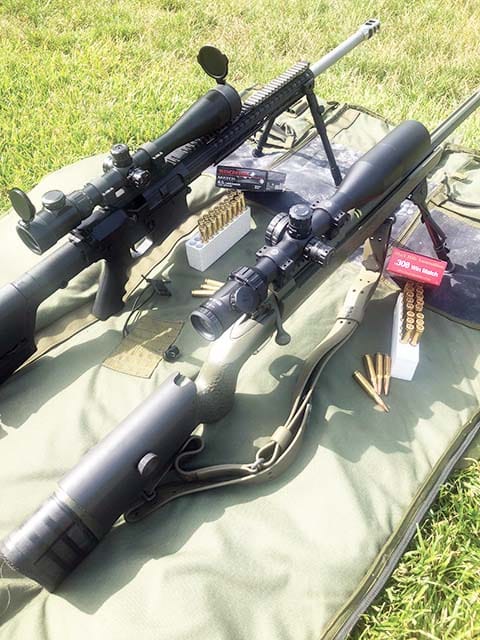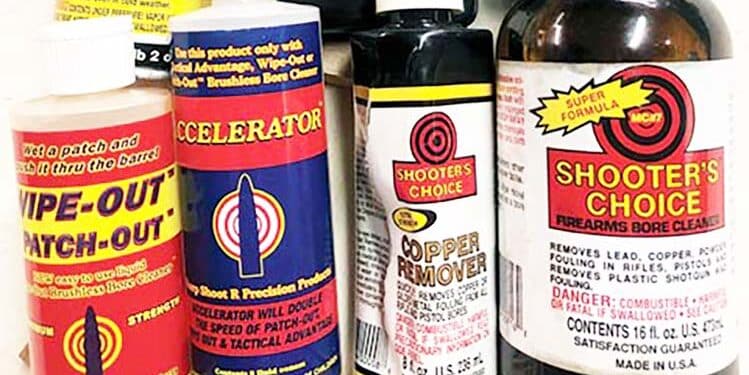Story & Photography by Paul Evancoe
Today’s computer-aided design, precision machining processes and exact-ing quality assurance offer a consistent level of firearms accuracy never before achieved in off-the-shelf firearms. This result is not only realized in today’s machining and fabrication processes, but in metallurgical and material quality as well. The outcome is firearms that shoot with acceptable accuracy and operate reliably right out of the box. But firearms manufacturing tolerances are tricky things—they can work for or against you depending upon the purpose of your firearm. Additionally, it is very easy to take a perfectly fine shooting gun and mess it up beyond repair without realizing one is doing so.
As a general rule of thumb, tolerance “slop” increases reliability but reduces accuracy and vice versa. This is to say that tighter fit-ting tolerances (less slop—as found on precision rifles and handguns) increase accuracy. Looser tolerances (more slop—as found on military assault weapons and many sport-ing firearms) increase reliability but sacrifice accuracy in the process. This is a discussion that is seldom considered by all but precision shooters (and even fewer weapon designers), and it is a primary contributor to weapons’ accuracy. On the flip side, sporting firearms attempt to find a happy medium between competitive accuracy and field-use reliability. Most precision rifles and handguns used in competition (and other purposes like sniping) require extreme accuracy. As such, they are largely hand-built in the firearms manufacturer’s custom shop or by a reputable precision gunsmith who specializes in such things. These firearms are made to meet a specific purpose.
They possess competition barrels, competition triggers, carefully lapped, hand-fitted parts, tuned competition springs and are tweaked for weight and balance. Taking an off-the-shelf field gun and turning it into a precision firearm, in nearly all cases, mean re-barreling, replacing most all moving parts with hand-fitted parts and competition springs. It’s an expensive and somewhat timely process that is usually done by professional gunsmiths who specialize in accurizing a particular brand or type of firearm. Accurizing is not something a hobbyist can accomplish by changing out cheap unfitted factory parts with expensive aftermarket parts, even though the aftermarket for such parts advertises otherwise.

Weapon Wear
A major degrading influence on accuracy is weapon wear. Clearly, metal-on-metal friction upon a gun’s operating system, e.g., parts that move and require lubrication, will, over time, become worn and sloppy. Things like bolts, bolt carrier groups, firing pins, slides, hammers, triggers, safeties and magazine releases, etc., will become worn over numerous firing cycles. Judicious cleaning and lubrication will slow the wearing process and extend the part–tolerance lifespan, but wear will occur nonetheless. The important point here is that firearms’ parts don’t wear evenly or uniformly at the same rate. For example, an AR’s bolt carrier group (BCG) guide rails may wear faster than the bolt lugs. The bolt will still go into battery on the forward stroke, but the BCG is worn outside the manufacturer’s specified tolerance (sloppy), causing unreliable BCG travel that, in turn, results in chambering/head spacing issues. The cumulative result is loss of accuracy and a higher malfunction potential.
Barrel Life
Accuracy is also a factor of barrel life. A little understood factor is why barrels lose accuracy over time or for some other unexplainable reason. Let’s assume your precision rifle has a precision match-grade barrel. It has performed superbly over many years, but you notice the gun’s accuracy is slowly dropping off. You’ve meticulously maintained your gun. The entire gun’s moving parts are tight and within tolerance. In fact, you’ve only fired about 1,600 rounds though the barrel and cleaned the bore every 15 to 20 rounds fired. So what else could it be?
Believe it or not, a barrel’s useful life is measured in bullet-in-barrel seconds, and most barrels wear out in only a few seconds. While this may seem to be a rather abstract, if not absurd presumption, it is exactly the opposite. Let’s walk through this using another example. Let’s say we have a bolt rifle with a 24-inch barrel, and it’s chambered to fire a round with a bullet velocity of around 3,000 feet per second (fps). At that velocity, the bullet will transit the 24-inch barrel in about 1/1500 of a second. This translates to your rifle actually having a bullet-in-barrel operating time of about .002 seconds each time you fire a round. Why is this important and so what?
In the finance world, the term “follow the money” is how spending is tracked. In the firearms world, we track the bullet—so here goes. Continuing the example above: At the moment of firing, the bullet starts at zero velocity and accelerates through the bore at the speed of the rapidly expanding propel-lant gases. Even though the bullet exits the muzzle at 3,000 fps, the actual zero velocity to 3,000 fps takes .002 seconds. Therefore, the actual time the bullet resides in the bore is .002 seconds, and this is the number used to calculate bore life. Therefore, if your barrel is rated to have a useful life of 3,000 rounds, its transcribed bore life is about 5 seconds. This figure will obviously vary depending upon the caliber, bullet velocity and length of barrel, because the bullet is not necessarily under constant acceleration (especially in lower velocity bullets traveling down longer length bores).
So how is this important to accuracy? In recognition that the .002 seconds in-bore time is a general number, it is a good average number to use for most centerfire gun barrel life calculations. Remarkably, it means the average gun has an accurate cumulative bul-let-firing barrel lifespan of only 4 to 10 seconds, maybe less. As mentioned, different calibers have different barrel life expectancies. A .300 WinMag barrel has a life expectancy of about 1,000 rounds (that’s barely a 2-second barrel life); .243 Win/.284/6.5mm barrels mostly experience an accuracy drop off around 1,500 rounds (that’s less than a 3-second life expectancy). On the larger-lived side, .308/7.62 NATO barrels lose accuracy around 5,000 rounds (that’s almost a 10-second life expectancy and old age as barrels live).
The object is to narrow the variablesto the greatest extent possible with the goal of achieving the tightest groups.
Logically, one of the reasons NATO has stuck with the 7.62×51 round is its offering of a somewhat long-lived barrel life expectancy. We would hope that USSOCOM has considered the barrel life dynamic before switching its machine guns and other firearms from 7.62 NATO to 6.5 Creedmoor, as has been recently advertised. As one might easily deduce, a machine gun that fires 800 to 900 rounds a minute can quickly reach its barrel life expectancy in a few seconds of sustained firing if it’s chambered in a short-lived caliber. Furthermore, most machine guns come with one replacement barrel that has been factory-fitted and is unique to a particular serial numbered gun. This means when both barrels are worn out, the gun requires depot-level maintenance and the fitting of two new replacement barrels. This is costly and requires the availability of replacement guns during the maintenance down time. These are just a few of the factors to consider when switching to calibers with inherently less barrel life.

Sporting Rifles
The above life expectancy issues hold true in sporting firearms as well, but most sporting firearms are never fired that often, so the accuracy degradation is far less noticeable. Most sporting rifles on average are fired less than 20 rounds a year. Moreover, most sporting firearms users don’t require precision. If they can reliably drop a deer at 100 yards using an off-the-shelf (non-precision) sporting firearm and readily available off-the-shelf sporting ammunition, they’re happy with the marksmanship bragging rights associated.
In view of the cost of precision firearms—or even sporting firearms—barrel life expectancy must be a critical consideration along with understanding how short-lived that really is. Keeping an accurate logbook count of every round one fires for each gun he relies upon for accuracy will provide the user a means to anticipate declining accuracy and barrel longevity. So—before contact-ing Shilen, Bartlein or Krieger and spending $600 to $800 to re-barrel a gun, do the bar-rel life-expectancy analysis to make sure the right thing is fixed.
How to Extend Barrel Life
There are things one can do to extend bar-rel life. Reducing heat by slowing the shooting pace will reduce overall barrel wear and wear across the gun’s operating system. Reducing the burn heat of the powder used in the cartridge is a second life extender and reducer of throat erosion. If you’re reloading, that’s a relatively easy fix. Use a cooler burning powder. If you’re buying match ammunition, be careful what you choose to shoot and never ever practice with other than the same match ammunition you use in competition. Remember, every round you fire subtracts time off your barrel life.
Another bore life extender is to change barrel cleaning methods. Stop using a bore brush to clean the gun. While it may not seem so, brushing drags abrasive material through the bore, which causes wear as well as damage to the lands and grooves by rounding their shoulders. Use powder and lead/cop-per solvents that reduce or eliminate the need for aggressive brushing and patch-clean the firearms. Eliminate the use of abrasive cleaners and methods altogether. Also, always use a properly fitting bore guide. It is not uncommon to see barrels that have been damaged or prematurely worn out from improper cleaning techniques. The military is famous for this and has done little to recognize or to rectify the problem.
There are other negative-accuracy sins that can be unknowingly committed. When breaking in a new gun don’t, repeat don’t, use the old “shoot one or two rounds, then clean and repeat multiple times” procedure until the shot grouping settles in. That adds needless wear on the bore that actually accomplishes little for break-in. It’s far better to shoot competitive group numbers and clean the bore using the same repetition one would use in competition. The new gun will settle into acceptable shot groupings far faster with less bore wear and overall, you will accomplish the break-in using less bore seconds (remember, every round fired subtracts from the barrel life expectancy).
Finally, the ammunition used is critical to the gun’s performance. Shooting match ammunition through a field (non-precision) gun may improve your grouping slightly, but it surely does not justify the additional cost of match ammunition. On the flip side, shooting other than match-grade ammunition through a precision firearm can be permanently destructive to the gun, and it won’t take many rounds to do the damage. The object is to narrow the variables to the greatest extent possible with the goal of achieving the tightest groups.
| This article first appeared in Small Arms Review V23N8 (Oct 2019) |












